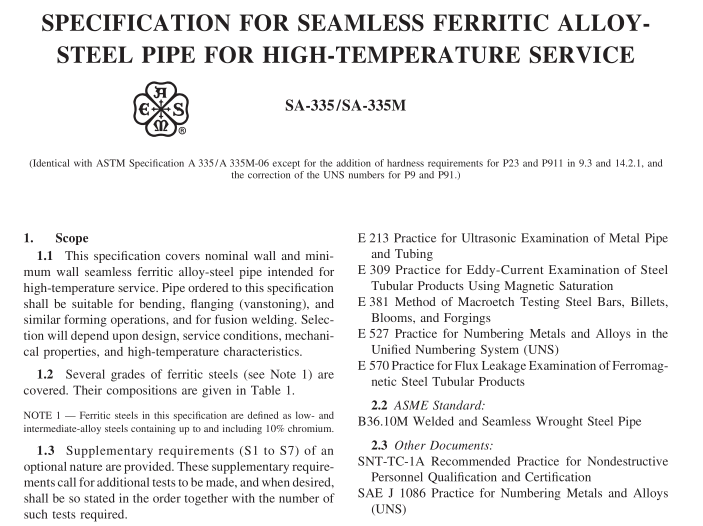ASME SA335 pdf download

ASME SA335 pdf download SPECIFICATION FOR SEAMLESS FERRIITIC ALLOY-STEEL PIPE FOR HIGH-TEMPERATURE SERVICE
13.2 The following information is for the benefit of the user of this specification:
13.2.1 The reference standards defined in 13.8 are convenient standards for standardization of nondestructive examination equipment. The dimensions ofthese standards should not be construed as the minimum size imperfection detectable by such equipment.
13.2.2 Ultrasonic examination can be performed to detect both longitudinally andtransversely orienteddiscon- tinuities. It should be recognized that different techniques shouldbe employedto detect differently orientedimperfec- tions. The examination may not detect short, deep imper- fections.
13.2.3 The eddy current examination referenced in this specification has the capability to detect significant discontinuities, especially of the short abrupt type.
13.2.4 The flux leakage examination referred to in this specification is capable of detecting the presence and location of significant longitudinally or transversely ori- ented discontinuities. It should be recognized that different techniques should be employed to detect differently ori- ented imperfections.
13.2.5 The hydrostatic test of Section 12 has the capability to find imperfections of a size that permit the test fluid to leak through the pipe wall so that it may be either visually seen or detected by a loss of fluid pressure. This test may not detect very tight, through-wall imperfec- tions, or imperfections that extend into the wall without complete penetration.
13.2.6 A purchaser interested in ascertaining the nature (type, size, location, and orientation) of discontinu- ities that can be detected in the specific application ofthese examinations should discuss this with the manufacturer of the tubular products.
13.3 Time ofExamination:
13.3.1 Nondestructive examination for specification acceptance shall be performed after all mechanical pro- cessing, heat treatments and straightening operations. This requirement does not preclude additional testing at earlier stages in the processing.
13.4 Surface Conditions:
13.4.1 All surfaces shall be clean and free of scale, dirt, grease, paint, or other foreign material that could interfere with interpretation of test results. The methods used for cleaning and preparing the surfaces for examina- tion shall not be detrimental to the base metal or the surface finish.
13.4.2 Excessive surface roughness ordeep scratches can produce signals that interfere with the test (see 13.10.2.3).
13.5 Extent ofExamination:
13.5.1 The relative motion of the pipe and the trans- ducer(s), coil(s), or sensor(s) shall be such that the entire pipe surface is scanned, except for end effects as noted in 13.5.2.
13.5.2 The existence of end effects is recognized, and the extent of such effects shall be determined by the manufacturer, and, if requested, shall be reported to the purchaser. Other nondestructive tests may be applied to the end areas, subject to agreement between the purchaser and the manufacturer.
13.6 Operator Qualifications — The test unit operator shall be certified in accordance with SNT-TC-1A, or an equivalent, recognized and documented standard.
13.7 Test Conditions:
13.7.1 For examination by the ultrasonic method, the minimum nominal transducer frequency shall be 2.25 MHz.
13.7.2 For eddy current testing, the excitation coil frequency shall be 10 kHz, or less.
13.8 Reference Standards:
13.8.1 Reference standards of convenient length shall be prepared from a length of pipe of the same grade, size (NPS or outside diameter and schedule or wall thick- ness), surface finish and heat treatment condition as the pipe to be examined.
13.8.2 For ultrasonic testing, the reference notches shall be any one of the three common notch shapes shown in Practice E 213, at the option of the manufacturer. The depth of the notch shall not exceed 12 1 ⁄ 2 % of the specified nominal wall thickness of the pipe or 0.004 in. (0.1 mm), whichever is greater. The length of the notch shall be at least twice the diameter of the transducer(s). The width of the notch shall not exceed the depth. 13.8.3 For eddy current testing, the reference stan- dard shall contain, at the option of the manufacturer, any one of the following discontinuities:









